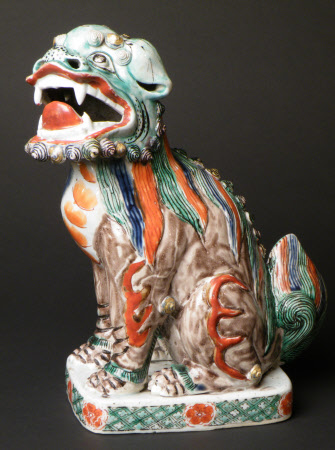Buddhistic lion
Category
Ceramics
Date
1662 - 1722
Materials
biscuit porcelain
Measurements
260 mm (H)
Order this imageCollection
Polesden Lacey, Surrey
NT 1245680.2
Summary
One of a pair of Buddhistic lions or Dogs of Fo, porcelain, each seated on their haunches, the head looking to the left, painted in the wucai (five-colour) enamel palette of green, iron-red, blue, yellow, aubergine and black, their foreheads are painted with the Chinese character ‘Wang’, meaning king or ruler, in red; made in China, at the Jingdezhen kilns, during the Kangxi period (1662-1722), c.1685-1700. There is a pair in the Porzellansammlung, Staatliche Kunstsammlungen Dresden, Germany (N:339), which was acquired before 1779 and another pair is in the Sowell Collection (see Cohen & Cohen, Mandarin & Menagerie, 2008, cat no.15.6). None of these examples were conceived as confronting pairs, unlike traditional Chinese Dogs of Fo, which were made as a male with celestial pearl and a female with a pup. The same workshop produced seated hunting hounds with bells tied to their necks, a pair of which were at Ham House until the 1940s. These Chinese mythical beasts are thought to have been inspired by Japanese Kakiemon-style porcelain models of karashishi (Chinese lions), c.1670-90: a Japanese pair at Burghley House, Stamford, Lincolnshire, may possibly be the ‘2 lyons’ listed in 1688 inventory, and another pair are at Drayton House, Northamptonshire. Japanese pairs supported on similar low bases, often have an open or closed jaw that form the mantra syllables ‘ah’ and ‘um’.
Provenance
The bequest of Margaret (Anderson) McEwan, The Hon. Mrs Ronald - later Dame Margaret - Henry Fulke Greville, DBE (1863-1942) from probate records linked with the donation of the property to the National Trust in 1943. This item found on the record for Polesden Lacey Chinese porcelain stored in the Basement, page 86.

